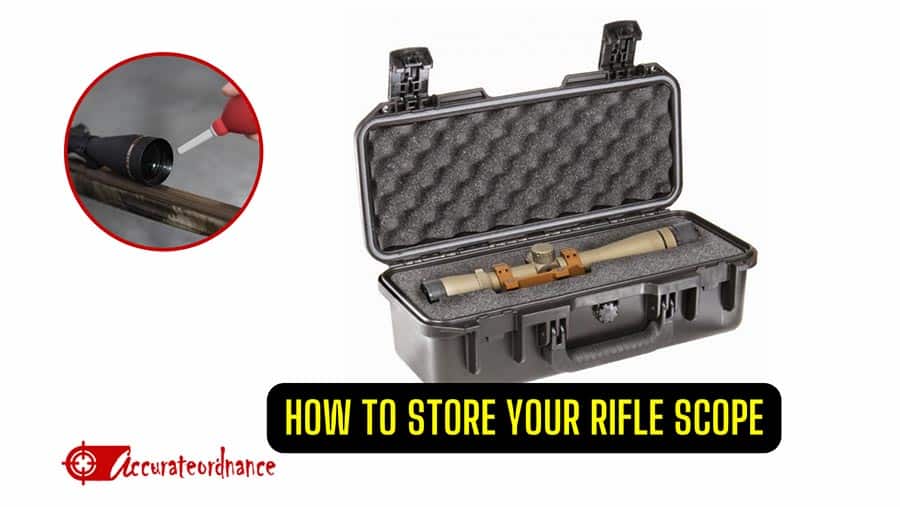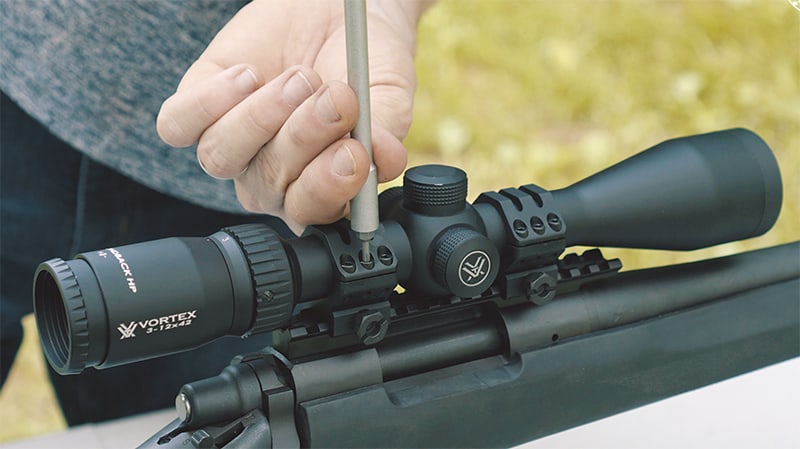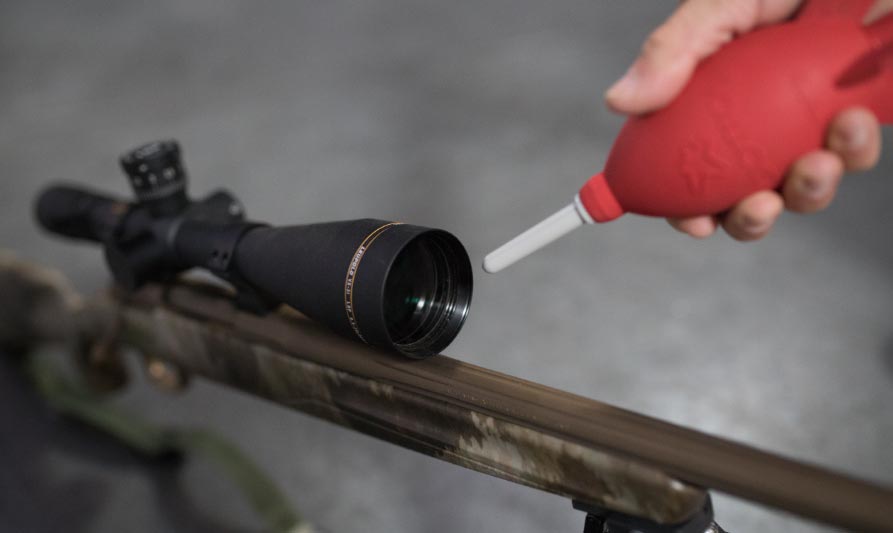Welcome to the world of riflescope care and maintenance, where the journey to precision begins long before you pull the trigger. Just as an artist cares for their brushes or a musician nurtures their instrument, a shooter must tend to their rifle scope. Your scope is not just a piece of gear; it’s your key to unlocking accuracy and consistency; as a result, any dent on the scope can mar your shooting or hunting precision.

Whether you’re a competitive shooter, an avid hunter, or an aspiring enthusiast, the first thing you need to understand before honing your shooting skills is how to keep your scope in pristine condition. And that’s exactly what we’re going to look at in this article. Let’s start with a brief on the reason why you should store your scope properly.
- Importance of Proper Storage for Riflescopes
- Choosing an Ideal Storage Environment
- Disassembly and Cleaning Before Storage
- Protecting Your Scope Using Scope Covers and Cases
- Regular Inspection and Maintenance Routine
- Common Mistakes to Avoid When Storing Your Rifle Scope
- FAQs
- How often should I clean my rifle scope?
- Is it necessary to remove the scope from the rifle for storage?
- Can I store my rifle scope in a hard case?
- What is the best way to protect my rifle scope from moisture?
- Should I use a lens cover when storing my riflescope?
- How do I prevent scratches on my rifle scope during storage?
- Can I store my rifle scope in a basement or garage?
- Can I use any cleaning solution to clean my rifle scope lenses?
Importance of Proper Storage for Riflescopes
Storing your scope correctly is crucial for preserving its optical and mechanical integrity. The investment you’ve made in acquiring a quality scope can quickly lose its value if the scope is not stored in a suitable environment. Several factors underscore the importance of proper storage:
- Protection from Physical Damage
Riflescopes are delicate instruments that are susceptible to impact damage. Storing them in a safe and secure manner helps prevent accidental knocks, drops, or impacts that can compromise their accuracy and functionality. One of the ways most professional shooters store their scopes to prevent physical damage is by using a rifle case. You can find some of the best scoped rifle case here!
- Preservation of Lens Coatings
The lenses of riflescopes are often coated to enhance light transmission, clarity, and contrast. Exposure to dust, dirt, and abrasive surfaces can lead to scratches and abrasions on these coatings, diminishing optical performance.
- Avoiding Moisture and Humidity
Moisture and humidity are potential enemies of riflescopes. Improper storage in damp conditions can lead to fogging of internal optics, corrosion of metal parts, and even the growth of mold or mildew. These issues can irreversibly damage the scope.
- Preventing Sunlight Exposure
Direct sunlight can degrade lens coatings and materials over time. Ultraviolet rays can cause fading and deterioration, negatively impacting image quality and clarity.
- Reticle Integrity
A stable storage environment helps maintain the integrity of the reticle. Keeping the reticle undisturbed ensures consistent aiming and accurate shots.
Now that we’ve known the major reasons why we need to store our scope adequately let us go in-depth into how to ensure your scope integrity is maintained.
Choosing an Ideal Storage Environment
Caring for your riflescope involves more than just keeping the body clean. You need to find the ideal spot to make sure it stays awesome for a long time. This special place, or environment, can really change how well your scope works. Let’s explore the important things to consider when picking the perfect home for your scope.
Right Temperature

Think of your scope as a delicate instrument that prefers stability. It functions best within a temperature range of about 50 to 70 degrees Fahrenheit (10 to 21 degrees Celsius). If the temperature fluctuations range goes outside this range, it can stress the internal components of the scope and affect its accuracy. Extreme temperatures—whether icy cold or scorching heat—can cause materials to expand or contract, leading to misalignment or distortion. These conditions can cause parts within your scope to behave strangely. Seals may weaken, and metals may warp.
Humidity on Scope Components

Humidity, which is the amount of moisture in the air, can be a sneaky adversary. High humidity levels can encourage moisture to seep into your scope’s internal crevices. This unwelcome guest can lead to rust, corrosion, and even the growth of mold over time. Beyond compromising the structural integrity of your scope, humidity can diminish its optical clarity, affecting your view through the lenses.
Avoiding Sun and Moisture Trouble
Just like you wouldn’t leave your favorite gadget out in the rain or bright sun, your riflescope needs protection from the elements too. Direct sunlight is a villain to your scope —it can fade the special coatings on your scope’s lenses and weaken its parts over time. Rain, dew, and moisture are silent troublemakers, finding their way into even the tiniest openings and causing hidden damage that can’t be undone. To keep your scope in top shape, find a cozy, shady spot for it and shield it from moisture. Remember, a little care goes a long way in keeping your scope ready for action when you need it.
Proper Ventilation to Prevent Condensation
Imagine your scope getting all foggy, like a window on a cold day. That’s what can happen when your scope gets too humid inside. I know we have talked about how humidity can be a villain to your scope, but we cannot rule humidity out completely; a little air movement, like a gentle breeze, can make a big difference. Think of it as giving your scope a breath of fresh air. Proper ventilation, which means letting some air flow, helps stop moisture from building up inside your scope. This prevents condensation, which is like tiny water droplets forming on cold surfaces. So, let your scope have a breath of fresh air—it’ll thank you by staying clear and fog-free.
Storage Environment on Lens Coatings
Imagine your scope’s lenses as the windows that let you see clearly. But just like windows can get dirty, your scope’s lenses can get smudged too. Keeping your scope in a rough environment can create tiny scratches on the lens coatings, which affects how much light gets through and how clear your view is. Dust and debris that settle on the lenses can make these scratches even worse over time. To keep your view sharp, make sure your scope lives in a clean, safe place where it won’t get scratched or dusty. That way, your scope’s lenses can stay as clear as a sunny day.
Disassembly and Cleaning Before Storage
Properly caring for your scope goes beyond just using it on the field—it involves ensuring its well-being even during periods of rest. Before tucking your scope away, disassemble and clean it meticulously. This practice not only maintains its appearance but also preserves its performance. Let’s delve into the steps for disassembly and cleaning to ensure your scope remains in top shape for years to come.
Safely Removing the Scope from the Rifle

Start by gently detaching the scope from your rifle. Follow the manufacturer’s guidelines to ensure you’re doing it the right way. Taking your time and handling it carefully helps prevent accidental damage to your scope or rifle.
Cleaning the Scope Body and Exterior Components

Use Gentle Cleaning Solutions: Clean the outer surfaces of your scope using mild cleaning solutions. Avoid harsh chemicals that might damage the scope’s finish. A mix of water and a drop of dish soap can also work wonders.
Microfiber Cloths and Soft Brushes for Cleaning: Utilize microfiber cloths and soft brushes to remove dust, dirt, and fingerprints. These materials are gentle on your scope’s exterior while effectively cleaning it.
Cleaning and Protecting Lens Surfaces
Proper Lens Cleaning Techniques: Cleaning your scope’s lenses is crucial for maintaining clear optics. Use a blower or brush to remove larger particles before touching the lens. If you need to touch the lens, use a lens cleaning solution and a microfiber cloth. Gently wipe in a circular motion from the center outward.
Using Lens Cleaning Kits: Investing in a lens cleaning kit can provide the tools needed for proper lens maintenance. These kits typically include a blower, brushes, cleaning solution, and microfiber cloths.
Applying Lens Protection Coatings: Some lens coatings repel dust, moisture, and fingerprints. If your scope doesn’t have these coatings, you can consider applying a protective coating designed for optics. This can help reduce the frequency of cleaning and maintain your lens’s performance.
Protecting Your Scope Using Scope Covers and Cases
Imagine you’ve just returned from a successful day of shooting, and now it’s time to put away your rifle and scope. But have you ever considered using a scope case or cover? These accessories shield your scope from the elements and accidental damage. In fact, these covers and cases aren’t just accessories; they’re an investment in preserving the longevity and performance of your valuable optic instrument.
Why Scope Covers?
Imagine the lenses of your scope as its eyes. Just like you’d protect your own eyes with sunglasses, scope covers shield your lenses from harm. Dust, raindrops, and minor impacts can all take a toll on the delicate optics of your scope. By keeping your lenses covered when you’re not actively using the scope, you’re ensuring that they remain pristine and ready to provide a clear and sharp view when you need it most.
Types of Scope Covers Available
Flip-Up Covers
These versatile covers act like protective doors for your scope’s lenses. When you’re ready to take a shot, you can flip them open, and when you’re done, you can close them for instant protection. They’re convenient and provide quick access while keeping your lenses safe from dust and bumps.

Application: Start with the scope’s lens caps in the open position. Align the caps over the lenses and gently press them down. They will click into place, covering the lenses securely. To use your scope, simply flip the caps open.
Removal: To remove, gently lift the flip-up caps by their edges. They should easily snap back to their open position. Make sure to avoid using excessive force, as it can damage the caps or lenses.
Neoprene Covers
Imagine these covers as soft, stretchy sleeves for your scope. They snugly fit around your scope, acting as a shield against scratches and minor impacts. Neoprene covers are perfect for situations where you need temporary protection in the field.

Application: Begin by holding your scope vertically. Slide the neoprene cover over the objective lens end and then pull it over the eyepiece end. Adjust the cover so that it fits snugly without straining the material.
Removal: Grip the neoprene cover and carefully slide it off the eyepiece end first, then slide it off the objective lens end. Be cautious not to tug or pull too hard, which could damage the cover or your scope.
Full Scope Cases
If you’re looking for all-around protection, full scope cases are the way to go. They envelop your entire scope, guarding it from every angle. These cases are ideal for long-term storage or when you’re traveling to shooting destinations.
Application: Open the case and lay it flat. Gently place your scope inside, ensuring that the eyepiece and objective lens are properly aligned with their respective openings. Close the case securely using the zippers or closures provided.
Removal: Unzip or open the case carefully. Lift the scope out gently, making sure not to bump it against the sides of the case. Avoid any sudden movements that could cause the scope to slip from your hands.
While putting on and taking off scope covers might seem straightforward, there are nuances to consider. When applying covers, ensure they fit snugly without applying excessive pressure. Covers that are too tight can inadvertently damage your scope. When removing covers, do so carefully to prevent accidentally knocking your scope or lenses.
Regular Inspection and Maintenance Routine
Owning a riflescope comes with the responsibility of regular care and attention. Just like any valuable tool, your scope needs a routine inspection and maintenance to ensure its longevity.
Establishing a Schedule for Scope Checks
Much like visiting the doctor for a checkup, your scope deserves a regular evaluation too. Set a schedule for these checks—consider doing them after every shooting session or at least once a month if your scope isn’t used frequently.
Inspect for Signs of Rust, Corrosion, or Damage
Begin your inspection by giving your scope a thorough visual scan. Look for signs of rust, corrosion, or any visible damage. Rust and corrosion can eat away at your scope’s metal parts, compromising its structural integrity. Even a small dent or scratch can impact its performance. Identifying these issues early allows you to take necessary action before they worsen.
Cleaning and Oiling Moving Parts
Just like a well-oiled machine, your scope’s moving parts need proper care. Use a soft brush to remove dust and debris from adjustment knobs, turrets, and other movable components. Then, apply a small amount of high-quality lubricant to ensure smooth movement. Be cautious not to overdo it; a little goes a long way.
Remember, a well-maintained scope not only delivers accurate shots but also ensures that you can rely on it whenever you’re ready to take aim.
Common Mistakes to Avoid When Storing Your Rifle Scope
Using Abrasive Cleaning Materials
Using rough or abrasive materials to clean your scope’s lenses or body can lead to scratches and damage. Always opt for soft materials like microfiber cloths and brushes specifically designed for optics to ensure safe and effective cleaning.
Improper Storage Position
Storing your scope in an unstable position or with uneven pressure can lead to misalignment and damage to internal components. Always store your scope in a secure and level position to prevent unnecessary stress.
Over-Tightening Scope Mounts
While it’s important to secure your scope mounts properly, over-tightening them can lead to bending or damaging the scope tube. Follow the manufacturer’s torque specifications to ensure the mounts are secure without causing harm.
Incorrect Lubricants
Using the wrong type of lubricant on your scope’s moving parts can cause more harm than good. Use high-quality lubricants specifically designed for optics and apply them sparingly.
Not Checking Battery-Powered Components
If your scope has illuminated reticles or other battery-powered features, neglecting to check the battery levels can lead to unexpected failures in crucial moments. Regularly inspect and replace batteries as needed to ensure your scope’s electronic components function properly.
Ignoring Manufacturer Guidelines
Each scope may have specific recommendations and guidelines for storage and maintenance. Ignoring or disregarding these instructions can lead to unintended damage or voided warranties.
FAQs
How often should I clean my rifle scope?
A general guideline is to clean your scope after every shooting session or at least once a month if not frequently used. However, the frequency of cleaning may vary based on factors such as environmental conditions, shooting frequency, and the level of dirt and debris encountered.
Is it necessary to remove the scope from the rifle for storage?
Yes, removing the scope from the rifle before storing it is highly recommended. Removing the scope reduces stress on its components and helps prevent unintentional damage during storage or transportation. Storing the scope separately in a protective case or cover shields it from potential impacts and environmental factors, ensuring it remains in optimal condition for your next shooting session.
Can I store my rifle scope in a hard case?
Yes, a hard case can provide excellent protection, especially during transportation or when the scope is not in use. Hard cases offer a sturdy and impact-resistant barrier against external hazards. However, ensure the case is properly padded and that the scope is securely placed to prevent any jostling or movement inside the case.
What is the best way to protect my rifle scope from moisture?
To protect your scope from moisture, store it in a dry and controlled environment with moderate humidity levels. Avoid sudden temperature changes that can cause condensation.
Should I use a lens cover when storing my riflescope?
Yes, using a lens cover when storing your scope is highly recommended. They help keep your lenses clean and scratch-free. Choose lens covers that securely fit and provide full coverage for both the objective and eyepiece lenses.
How do I prevent scratches on my rifle scope during storage?
Store the scope in a padded case or bag to prevent direct contact with hard surfaces. Avoid placing other objects on top of the scope that could scratch it.
Can I store my rifle scope in a basement or garage?
Storing your rifle scope in a basement or garage may not be ideal due to potential temperature and humidity fluctuations. Basements and garages are often prone to higher humidity levels, which can lead to moisture damage. Extreme temperatures and humidity can adversely affect your scope’s performance and lead to rust, corrosion, or mold growth. If you choose to store your scope in these areas, ensure you use proper protective measures.
Can I use any cleaning solution to clean my rifle scope lenses?
No, you should not use just any cleaning solution to clean your rifle scope lenses. Using the wrong cleaning solutions can damage lens coatings and affect optical performance.

Mike Hardesty is a published freelance gun writer. He also possesses specialized expertise in rifle scopes With dozens of articles and reviews published in Pew Pew Tactical, Snipercountry.com, and TTAG (The Truth About Guns), Mike is considered a firearms expert. His special area of expertise is handguns.
Mike is a long-time shooter. He has been punching paper targets, taking deer and other game and shooting at competitions since about 1975. Other related pursuits include reloading and bullet casting. He currently reloads for over 10 calibers, both handgun and rifle. His reloads, particularly for 9mm, were in great demand during the height of the ammo shortage among family and friends. He donated hundreds of rounds to informal shooting sessions. He was quoted as saying “I do not sell my reloads but I sure will help my guys shoot ’em for free!”. He has a few cherished firearms that he has inherited or otherwise procured — those are his favorites.
He earned B.S. and M.S. degrees from Indiana State University in 1974-1975.
He’s a firearm experts and is the founder of mhardesty.com.
